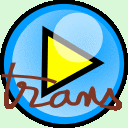Main features
Transcriptions
- management of several layers of segmentation: basic segmentation for orthographic transcription (e.g. at each sentence or at each breathing), speech turn segmentation (new speaker) and section segmentation (new topic...); these 3 layers are hierarchically embeded. A 4th segmentation in background acoustic conditions is also available
- annotation of named entities
- display of segmentations under the signal and in the text editor; display of each segmentation under the signal can be toggled with a contextual menu
- always synchronize the cursors in the text editor window and in the signal window: as soon as the cursor moves in one window, it is moved in the other one and appears within the same segment
- easy creation of the basic segmentation by the way of successive insertions of boundaries at current cursor position, even during playback
- move segment boundaries with the mouse
- insert mark of change in background acoustic condition (music, speech, other) at current cursor position in the signal
- indicate some boundaries as the beginning of a new speech turn or of a new section
- edition of turns, sections or background conditions with a mouse clic on the corresponding button in the editor, including possible destruction
- management of a speaker list with a precise description of each (name, type, accent...), further modification of its characteristics, research of turns involving a specific speaker, importation of speakers from another transcription
- in the same way, management of a list of topics, find sections about a topic, import topics from another file
- specific management of overlapping speech with marks for each speaker in the text editor
- insert predefined events (noise, pronouciation mark, lexical mark, language change) which can be instantaneous or be at the beginning or the end of the event; user defined display of events (font, color, format); edit or remove with a single clic on the event in the text
- standard text edition features: cut/copy/paste, find/replace, (very limited) undo
- glossary for predefined words or expressions
- transcriptions in XMl format for easier automatic processing and exchange; syntaxic validation of files upon their DTD
- user-chosen encoding is used for transcriptions input/output; most current encodings (iSO-8859-*, EuC-JP...) and unicode (uTF-8) can be used
- when opening a file, automatic research of corresponding sound file; if none is found, user is being asked to locate it.
- import .typ transcriptions in .typ format and various labelling (xwaves, OGi...); export to .typ and .stm
- periodic automatic backup
- keep previous version in backup file
Sound management
- read most standards audio formats (thanks to Snack library)
- handle long duration audio files (up to several hours) - for duration over 30 sec., a low-resolution view of the signal is computed in background and stored for speeding up later display
- direct access to any position in the signal; selection of part of the signal
- synchronized cursor during playback
- several playback modes through keyboard combinations: play/pause, play the current segment, the selection, around the cursor
- interactive change in resolution without stopping playback
- able to display two views of the signal at different resolutions
- vertical zoom
Other features
- display cursor position (also during playback), selection width and other messages under the signal
- monitoring of user's productivity during the session
- information window about the signal (filename, duration, format), about the transcription (number of segments, of words...) et optionnaly of the amount of work in the current session
- edit the list of predefined events (noise, pronounciation...)
- edit keyboard shortcuts for insertion of characters or strings (including events)
- font and colors user editable
- easy localization in any language (English and French provided)
- possible backup of the current state in a configuration file for use in the next session: open files, options, window position

